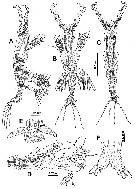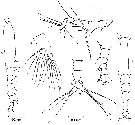|
|
 |
|
Monstrilloida ( Order ) |
|
|
|
Monstrillidae ( Family ) |
|
|
|
Cymbasoma ( Genus ) |
|
|
| |
Cymbasoma tenue (Isaac, 1974) (M) | |
| | | | | | | Syn.: | Thaumaleus tenuis Isaac, 1974 (p.134, Descr.M, figs.M); 1975 (p.7, 9, figs.M); Grygier, 1995 a (p.76) | | | | Ref.: | | | Suarez-Morales & Riccardi, 1997 (p.99, Redescr.M, figs.M, Rem.); Suarez-Morales, 2000 c (p.115, figs.M, Rem.); Vives & Shmeleva, 2010 (p.168, fig.M, Rem.) ; Suarez-Morales, 2011 (p.10); Grygier & Suarez-Morales, 2018 (p.499: Rem.) |  issued from : E. Suarez-Morales & N. Riccardi in Proc. Biol. Soc. Washington, 1997, 110 (1). [p.102, Fig.2]. Male (from Toulon Bay, NW Mediterranean Sea): A, habitus (dorsal); B, idem (lateral); C, cephalic region (dorsal) [arrow indicates protuberance]; D, right A1 (dorsal). Scales in mm. Nota: Cephalic anterior portion wider than body. Cephalothorax about 0.50 % of total body length. Oral papilla located less than 30 % of way back along ventral surface of cephalothorax. Dorsal ocelli present, pigment cups small and widely separated, poorly developed. Cephalic region in dorsal view with one central cuticular protuberance on forehead between pigment cups and paired small sensilla; two strongly chitinized, rounded cuticular processes located posterior to pigmented region of ocelli. A1 4-segmented, length about 37 % of total body length, and about 75 % as long as cephalothorax
|
 issued from : E. Suarez-Morales & N. Riccardi in Proc. Biol. Soc. Washington, 1997, 110 (1). [p.103, Fig.3]. Male: A, P1 (posterior); B, P2 (anterior); C, P3 (postrior); D, P4 (posterior); E, urosome and caudal rami (dorsal); F, genital complex and genital lappets (ventral). Scales in mm. Nota: Urosome consisting of 4 segments; 5th pedigerous somite (with no appendages), genital somite and 2 free somites. Genital somite (in dorsal view) about as long as preanal urosomites, anterior half expanded ventrally.; ratio of lengths of genital somite and two free psterior somites 34.6:23: 40 = 100; subtriangular protuberances on basal portion of each lappets, distally rounded. Caudal rami approximately 1.2 times wider than long, with 3 well developed terminal setae.
|
 issued from : E. Suarez-Morales in Bull. Inst. R. Sci. nat. Belgique, Biologie, 70, 2000. [p.116, Fig.6]. Male (from Toulon Harbor, Mediterranean Sea): A-C, habitus (lateral, ventral and dorsal, respectively); D, right A1 (dorsal); E, genital lappets (ventral view; showing basal denticles, arrowed). Nota: The specimen analysed shows some differences which show additional variation in this species: the forehead is noticeably lower than in the redescription (see Suarez-Morales & Riccardi, 1997), but it has the same type of cuticular corrugation. In both cases, the head abruptly broadens anterior to the oral papilla, although this is more evident in the specimens upon which this species was redescribed. Most importantly, the species is recognized by the structure of its genital lappets with a characteristic pair of sharp denticles on the bases. One of the main differences between this individual and those redescibed from the same locality, is the presence of only 2 caudal setae instead of 3 (as is commonly found in this genus).
|
 issued from : M.J. Isaac in J. mar. biol. Ass. U.K., 1974, 54. [p.134, Fig.6]. As Thaumaleus tenuis. Male (from Gulland Rock, Padstow): A, F, habitus (lateral and dorsal, respectively); B, P4; C, right A1 (ventral); D-E, last thoracic segment and abdomen (ventral and lateral, respectively).
| | | | | Compl. Ref.: | | | Jamet & Ferec-Corbel, 1996 (p.17, tab.1: as tenuis) | | | | NZ: | 2 | | |
|
Distribution map of Cymbasoma tenue by geographical zones
|
| | | | | | | Loc: | | | Bristol Channel (off Gulland Rock), NW Medit. (Toulon Harbour) | | | | N: | 4 | | | | Lg.: | | | (278)* M: ± 1,15; (731) M: ± 1,1; (828) M: 0,66-1,15; {M: 0,66-1,15}
* caudal rami excluded. | | | | Rem.: | Inshore. In vertical haul 0-22 m.
For Suarez-Morales & Riccardi (1997, p.104) the Mediterranean specimens show strong similarities, but also some differences with respect to the holotype and the original descriptions and illustrations. Suarez-Morales (2000 c, p.117) mentions the number of setae on the caudal rami has been used as a secondary characters to identify monstrilloid species. There is variation of this character in Monstrilla, but the only genus with 3 furcal setae is Cymbasoma; hence, this should then be modified to 3 or 2. For this author the length range of body is 0.66-1.15 mm (also 1.24); size variation may result from the size of the host and the number of individuals within the host (see Gallien, 1934).
For Suarez-Morales & al. (2017, p.1811), the male of C. pseudobidentatum closely resembles C. tenue (Isaac, 1975), these two species differ in subtle characters. In C. tenue the medial processes on the base of the genital lappets are clearly acute and smaller than in C. pseudobidentatum, in which these processes are apically rounded, thumb-like and relatively larger; also, the anal somite has a medial constriction, thus differing from C. tenue, lacking this character. In addition, the b-group setae on the outer margin of the last segment of A1 are unbranched in C. pseudobidentatum and branched in C. tenue. | | | Last update : 12/02/2020 | |
|
|
 Any use of this site for a publication will be mentioned with the following reference : Any use of this site for a publication will be mentioned with the following reference :
Razouls C., Desreumaux N., Kouwenberg J. and de Bovée F., 2005-2025. - Biodiversity of Marine Planktonic Copepods (morphology, geographical distribution and biological data). Sorbonne University, CNRS. Available at http://copepodes.obs-banyuls.fr/en [Accessed December 04, 2025] © copyright 2005-2025 Sorbonne University, CNRS
|
|
 |
 |







